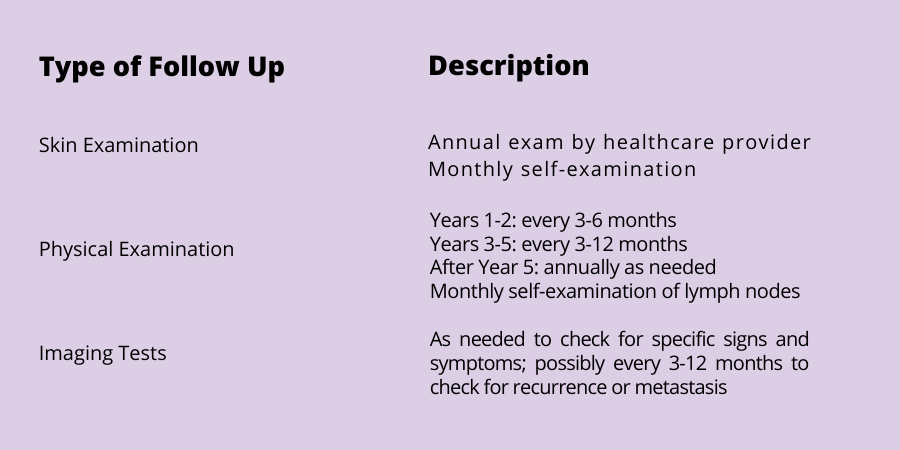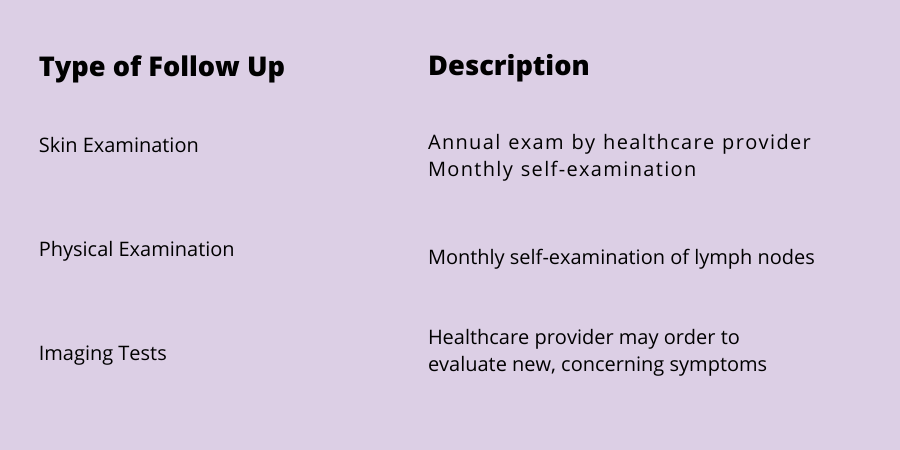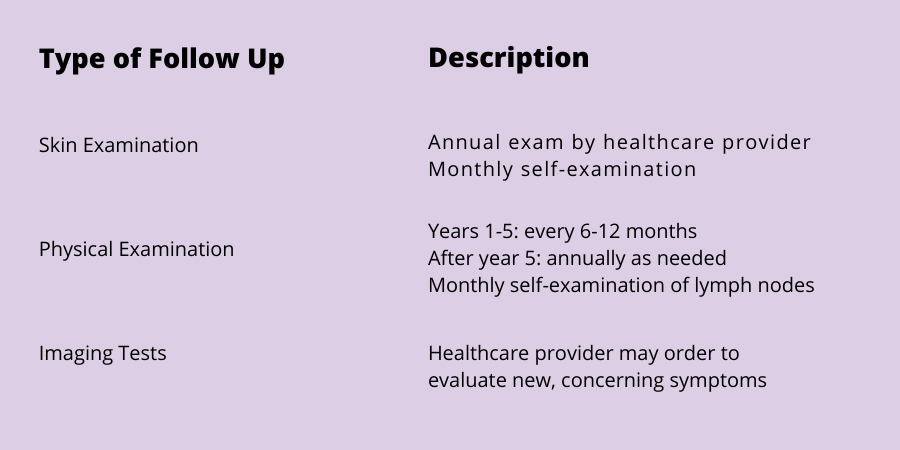Follow Up By Stage

What is Follow Up Care After Treatment?
Follow-up for a person with a history of melanoma is based on a person’s risk of recurrence and is highly individualized. While there are guidelines for follow up care for each stage of melanoma, your follow up care may look different from another person’s care who is the same stage.
At your visits, your health care team will look for signs that the melanoma has returned, look for second melanomas, watch for long-term side effects (called late effects), and monitor your overall health. Depending on your stage, your follow-up care plan may include regular physical and dermatologic examinations and/or medical tests to monitor your recovery. Follow-up care is especially important in the first five years after treatment because that period of time is when the risk of recurrence is highest.
Those who have had melanoma have an increased risk for developing a second melanoma and for recurrence—they’re different. Read more about developing a second melanoma here and about recurrence here.
Guidelines for follow-up care on this page come from the National Comprehensive Cancer Network (NCCN), a not-for-profit alliance of 27 leading cancer centers in the U.S. The NCCN panel for melanoma comprises key opinion leaders in melanoma from across the nation.
Stage 0 Follow-Up
After treatment, all patients with Stage 0 melanoma should receive examinations and tests according to the following guidelines:
All patients with Stage 0 melanoma should have a skin examination at least once a year for the rest of their lives. Imaging tests are performed if specific symptoms concerning for cancer appear.
Stage I Follow-Up
After treatment, all patients with Stage I melanoma should receive physical examinations, including skin examinations, according to the following guidelines:
All patients with Stage I melanoma should have a skin examination once a year. A physical examination should be performed every six to 12 months for the first five years, then once a year as needed. The frequency of the physical examinations depends on the perceived level of risk for new primary melanomas and for the recurrence of the previous tumor. Imaging tests are performed for specific symptoms.
Stage II Follow-Up
After treatment, all patients with Stage II melanoma should receive physical examinations, including skin examinations, according to the following guidelines. Other scans and tests may be recommended.
All patients with Stage IIA melanoma should have a skin examination once a year. A physical examination should be performed every six to 12 months for the first five years, then once a year as needed. The frequency of a physical examination depends on the perceived level of risk for new primary melanomas and for the recurrence of the previous tumor. Imaging tests are performed only for specific symptoms.
All patients with Stage IIB and IIC melanoma should have a skin examination once a year. Patients should have a physical examination every three to six months for the first two years; every three to 12 months for the next three years; and once a year as needed thereafter. Imaging tests are recommended if specific signs of cancer appear or may possibly be performed to screen for recurrence. Tests may include a chest x-ray, CT scan, PET/CT scan, and a brain MRI. These tests may be done for up to five years after treatment has ended. Imaging tests are not recommended after five years if there has been no recurrence and you don’t have any symptoms. If follow-up tests show that the cancer has come back, treatment options will depend on the type of recurrence.
Stage III Follow-Up
After treatment, all patients with Stage III melanoma should receive physical examinations, including skin examinations, according to the following guidelines. Surveillance CT of the chest, CT scans of the trunk and pelvis, and brain MRI may also be recommended.
All patients with Stage III melanoma should have a skin examination once a year for life. Patients should have a physical examination every three to six months for the first two years; every three to 12 months for the next three years; and once a year as needed thereafter.
Imaging tests are recommended if specific signs of cancer appear. You may also receive imaging tests every three to 12 months to check for cancer recurrence or metastasis that isn’t causing symptoms. Possible tests for screening include a chest x-ray, CT scan, PET/CT scan, and brain MRI. These tests may be done for up to five years after treatment has ended. Imaging tests are not recommended after five years if there has been no recurrence and no symptoms.
Stage IV Follow-Up
After treatment, all patients with Stage IV melanoma should receive physical examinations, including skin examinations, according to the following guidelines. Depending upon the circumstances, follow-up for patients may be required monthly or even weekly. Regular CT of the chest, CT scans of the trunk and pelvis, and brain MRI may also be recommended.

Stage IV melanoma that has been completely removed (NED = no evidence of disease) is usually followed closely in the clinic with physical exams, blood work, and scans every three to six months for at least the first two years, and then spaced out over time. These patients are followed at least annually after year five.
Imaging tests are recommended if specific signs of cancer appear. You may also receive imaging tests every three to 12 months to check for cancer recurrence that isn’t causing symptoms. Possible tests for screening include a chest x-ray, CT scan, PET/CT scan, and brain MRI. These tests may be done for up to five years after treatment has ended. Imaging tests are not recommended after five years if there has been no recurrence and no symptoms.




